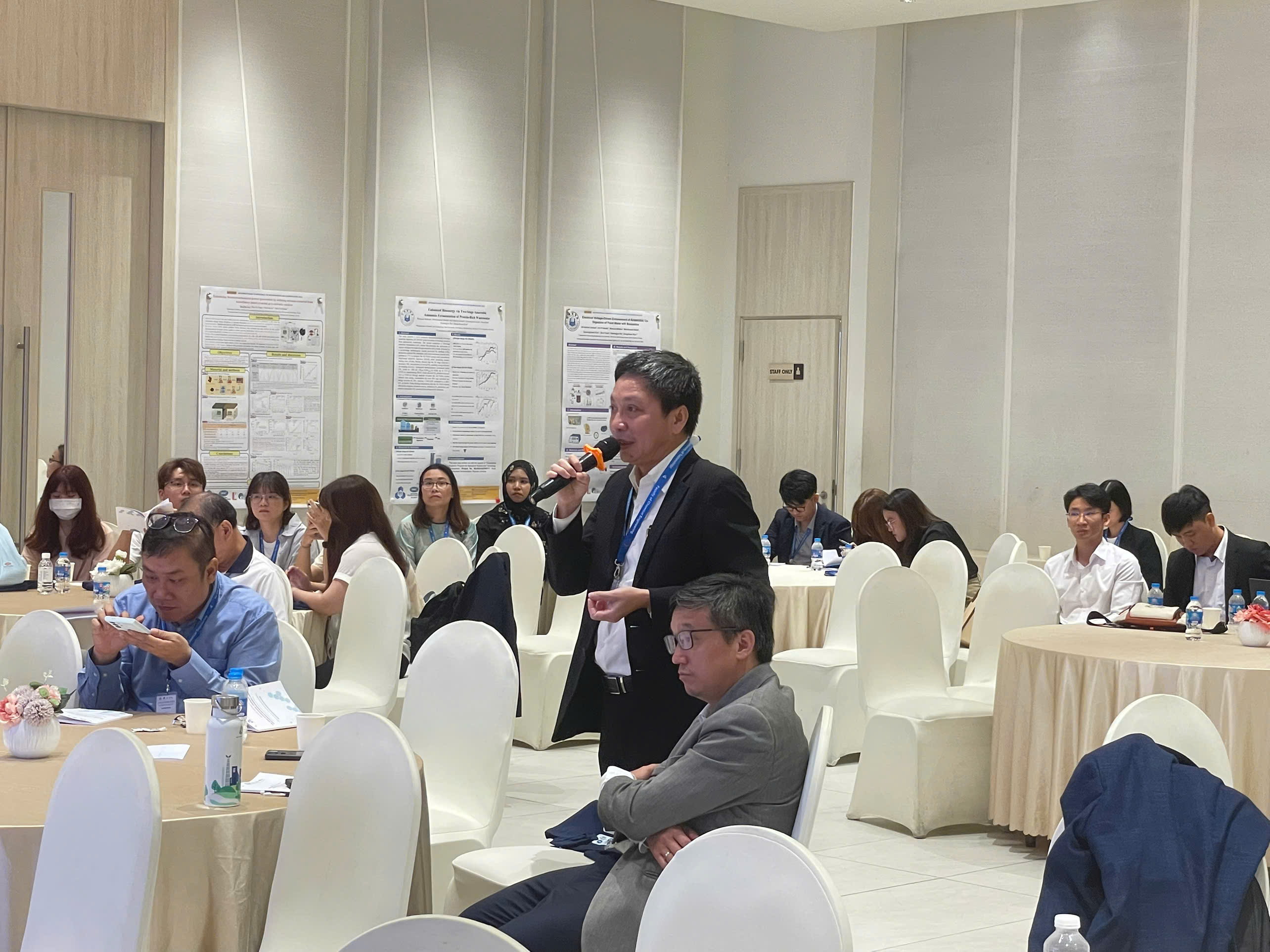Hydrogen Vision for Vietnam: From Emerging Potential to Regional Leadership
Keynote Address by Mr. Le Ngoc Anh Minh, Chairman of the Vietnam ASEAN Hydrogen Club (VAHC), at the ABBS 2025 International Conference on Biohydrogen and Bioprocesses – Ho Chi Minh City University of Technology, November 4, 2025

As the world races toward a net-zero future, hydrogen has become the missing link between renewable energy and industrial decarbonization. On November 4, 2025, at the ABBS 2025 International Conference on Biohydrogen and Bioprocesses, organized by the Ho Chi Minh City University of Technology, one of Vietnam’s most influential clean energy voices — Mr. Le Ngoc Anh Minh, Chairman of the Vietnam ASEAN Hydrogen Club (VAHC) — delivered a thought-provoking keynote titled:
“Business Opportunities and Strategic Pathways for Developing a Low-Emission Hydrogen Supply Chain in Vietnam.”
His presentation was not merely an academic report; it was a call to action — urging Vietnamese science, industry, and government to join hands in turning the country into a dynamic hydrogen hub of ASEAN.
From a Vision to a Movement: VAHC’s Mission in the Hydrogen Era
Founded in March 2023, the Vietnam ASEAN Hydrogen Club (VAHC) has quickly emerged as a regional platform uniting businesses, researchers, and policymakers around one goal: the establishment of a sustainable hydrogen economy.
Mr. Minh highlighted VAHC’s role in building what he called “a connected hydrogen community”, spanning the exchange of human resources, land, technology, know-how, finance, construction capacity, and hydrogen supply and consumption throughout Vietnam and the ASEAN region.
The Club has hosted monthly international seminars on hydrogen energy, facilitated partnerships between Vietnamese and Japanese corporations, and provided policy and technical consulting for clean energy projects.
Among VAHC’s concrete achievements are two pioneering initiatives:
-
Obayashi Corporation (Japan), a founding member of VAHC, secured USD 7 million from NEDO to develop a low-emission hydrogen production plant in Tay Ninh Province (2024–2028).
-
PV Gas — another VAHC member — is implementing a 1MW low-emission hydrogen demonstration project in Long Hai, Ho Chi Minh City, marking a first for Vietnam’s gas sector.
“These are not isolated projects,” Mr. Minh emphasized. “They are the early foundation blocks of Vietnam’s hydrogen value chain — a new frontier where industry, academia, and government must converge.”
The State of Hydrogen in Vietnam and the World
Vietnam’s hydrogen landscape, Mr. Minh noted, is still at an early stage. As of 2024, the country produces approximately 0.5 million tons of high-emission hydrogen per year, mainly from fossil fuels — while low-emission hydrogen output remains negligible.
However, the National Hydrogen Strategy provides a clear vision:
-
By 2030, Vietnam targets 100,000–500,000 tons per year of hydrogen production using renewable energy and carbon capture processes.
-
By 2050, that figure should rise to 10–20 million tons per year, forming a backbone of the country’s green industrial economy.
Globally, according to the IEA Global Hydrogen Review 2025, total hydrogen production in 2024 reached nearly 100 million tons, but only about 1% was low-emission hydrogen.
The implication is clear: Vietnam enters the hydrogen era at the right moment — when global markets are forming, technologies are maturing, and competition for supply chain positioning is intensifying.
Barriers and the Case for Hydrogen Communities
Mr. Minh provided a candid assessment of why low-emission hydrogen remains difficult to commercialize worldwide:
-
High R&D costs
-
Expensive equipment and technology
-
High cost of clean electricity and significant water demand — 9–10 liters per kilogram of hydrogen
-
Costly storage and transport
-
Limited market demand
-
Lack of clear standards and regulations
“These barriers are exactly why we established VAHC,” he said. “No single company or country can solve them alone. We need hydrogen communities — open ecosystems that connect technology providers, investors, research institutes, and policymakers.”

Vietnam’s Strategic Opportunities: Turning Challenges into Leadership
Mr. Minh outlined eight strategic opportunity pillars where Vietnamese enterprises can rise and lead.
1. Policy and Certification Advisory
Vietnamese consulting and legal firms can play a critical role in helping the government develop low-emission hydrogen and derivative fuel standards compatible with international frameworks.
Participation in mutual recognition schemes for hydrogen certification, as discussed at COP28 (with 44 countries signing a joint declaration), will be key for future exports.
2. Energy, Oil & Gas, and Heavy Industry Integration
Enterprises in electricity, oil & gas, refining, cement, steel, and chemicals will find new synergies through Power Development Plan VIII (PDP8) and the National Hydrogen Strategy, which encourage hybrid energy systems and CCUS integration.
3. Manufacturing Hydrogen Equipment
In late 2024, the European Commission limited Chinese electrolyzers to under 25% of EU Hydrogen Bank projects, creating new export opportunities.
Vietnamese firms such as LILAMA, HB-GREEN, and Ikonomy can leverage local manufacturing strength to produce electrolyzers and hydrogen ecosystem components for EU, Japanese, and Korean markets.
4. Hydrogen Injection in Diesel Engines
In July 2025, PV Gas, Greentek, and Long River successfully tested hydrogen injection technology for diesel engines in Vung Ang, Ha Tinh Province — achieving reductions in both fuel consumption and CO₂ emissions.
“This shows that decarbonization does not always require new engines — innovation can start with what we already have,” Mr. Minh noted.
5. Exploration of Natural Hydrogen
Natural hydrogen — newly discovered in Mali, France, Albania, Texas, Alaska, and Australia — could revolutionize the hydrogen market with production costs below USD 1/kg.
Vietnam, with decades of oil and gas expertise, can explore potential reserves in:
-
Offshore basins like Phu Khanh and Cuu Long (along rift zones and volcanic intrusions)
-
Onshore areas in the South Central Coast, Central Highlands, and Northwest regions
“This could be the next Doi Moi for our energy sector,” he said, referring to Vietnam’s historical economic reform.
6. Hydrogen in Agriculture
Hydrogen-enriched water and fertilizers can enhance crop yield and soil recovery — a field pioneered in Japan and now expanding into Southeast Asia.
Mr. Minh urged research institutes and agritech startups to “think hydrogen beyond energy.”
7. Water and Energy Co-Benefits
Approximately 40% of global hydrogen projects are located in water-scarce regions. Producing 1 kg of hydrogen consumes about 10 liters of water, and up to 70 liters including cooling.
Integrating seawater desalination with hydrogen projects can not only supply process water but also deliver clean water for coastal communities.
According to IEA data, desalination adds only 2% of total investment cost (≈USD 0.05/kg H₂) — a small price for dual environmental and social benefits.
8. Hydrogen and Health
Drawing from Japan’s success, hydrogen-based healthcare products such as hydrogen inhalers, hydro-spa treatments, and hydrogen-rich water are gaining recognition for anti-stress, anti-aging, and cancer-prevention benefits.
“This is a trillion-dollar wellness industry — and hydrogen can be part of it,” he said.

A Call to Action: Building Vietnam’s Hydrogen Future Together
Mr. Minh concluded his address with a passionate appeal:
“Hydrogen is not just a fuel — it is the lifeblood of a new green civilization. It links energy with environment, agriculture with water, and technology with human health.
Vietnam can and should lead this transformation. We already have the engineers, the industrial base, and the entrepreneurial spirit. What we need is unity of purpose and a shared roadmap.”
He called upon universities, state agencies, and private enterprises to join VAHC’s Hydrogen Community Initiative, to train the next generation of hydrogen engineers, and to position Vietnam as ASEAN’s center for hydrogen technology and trade.
About VAHC
The Vietnam ASEAN Hydrogen Club (VAHC) was established in March 2023 to promote collaboration and investment in hydrogen and new energy technologies in Vietnam and the ASEAN region.
Website: www.vahc.com.vn
Contact: contact@vahc.com.vn






